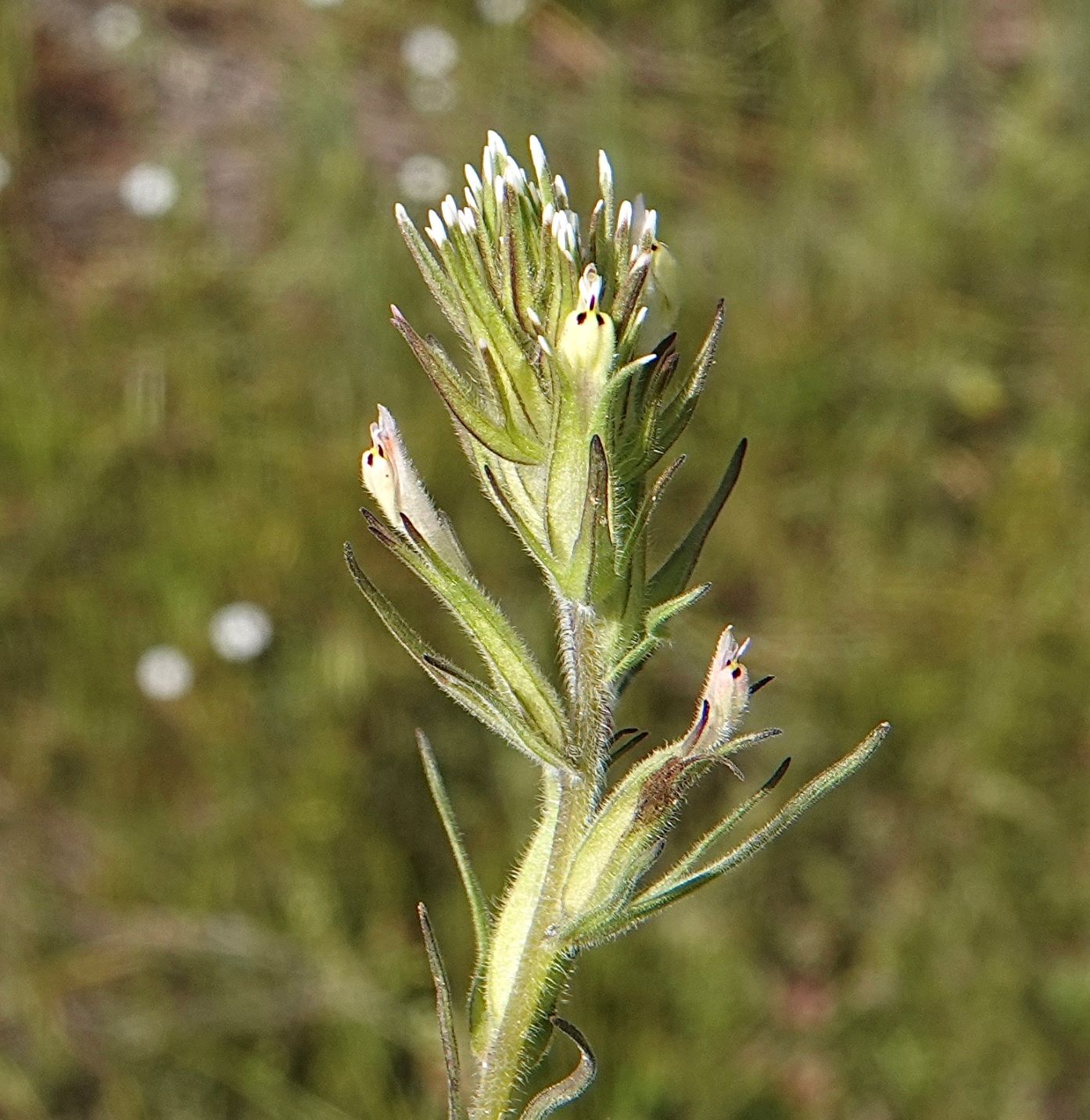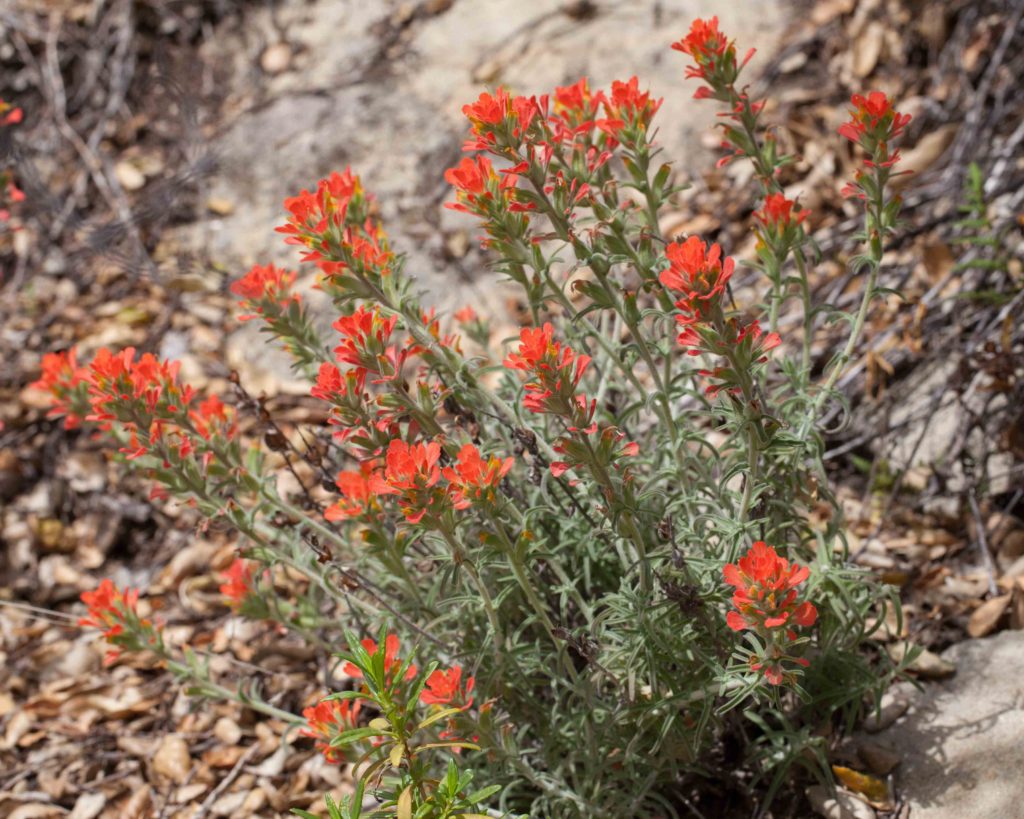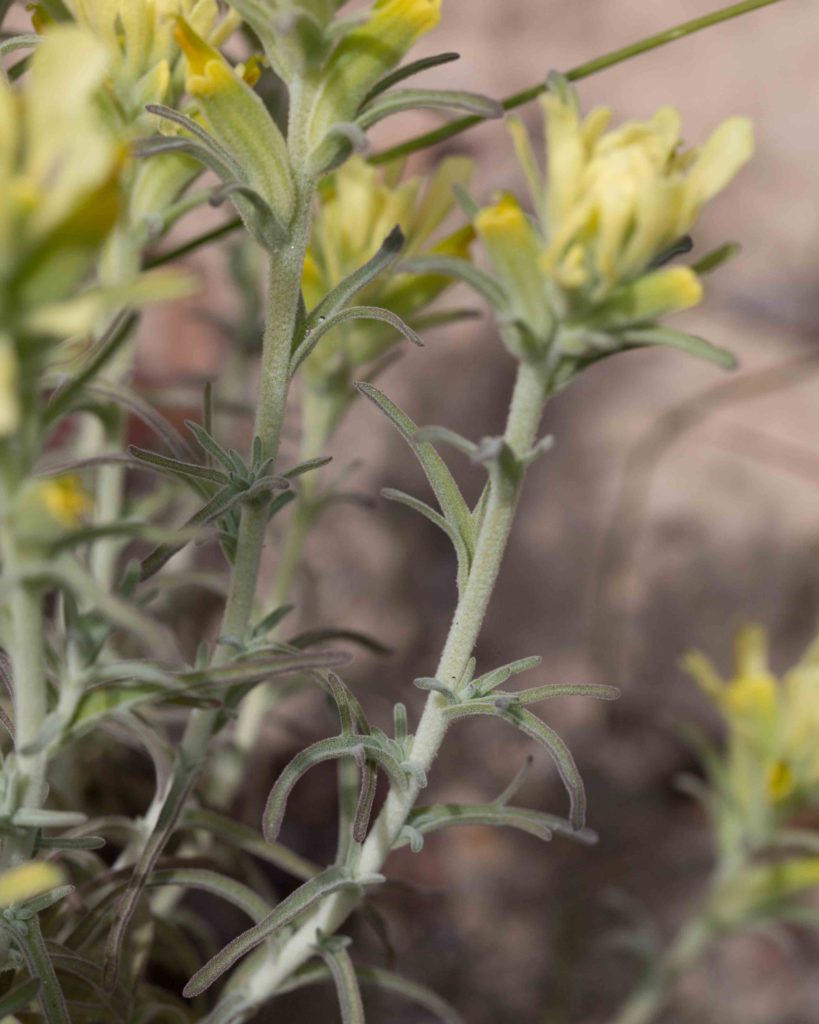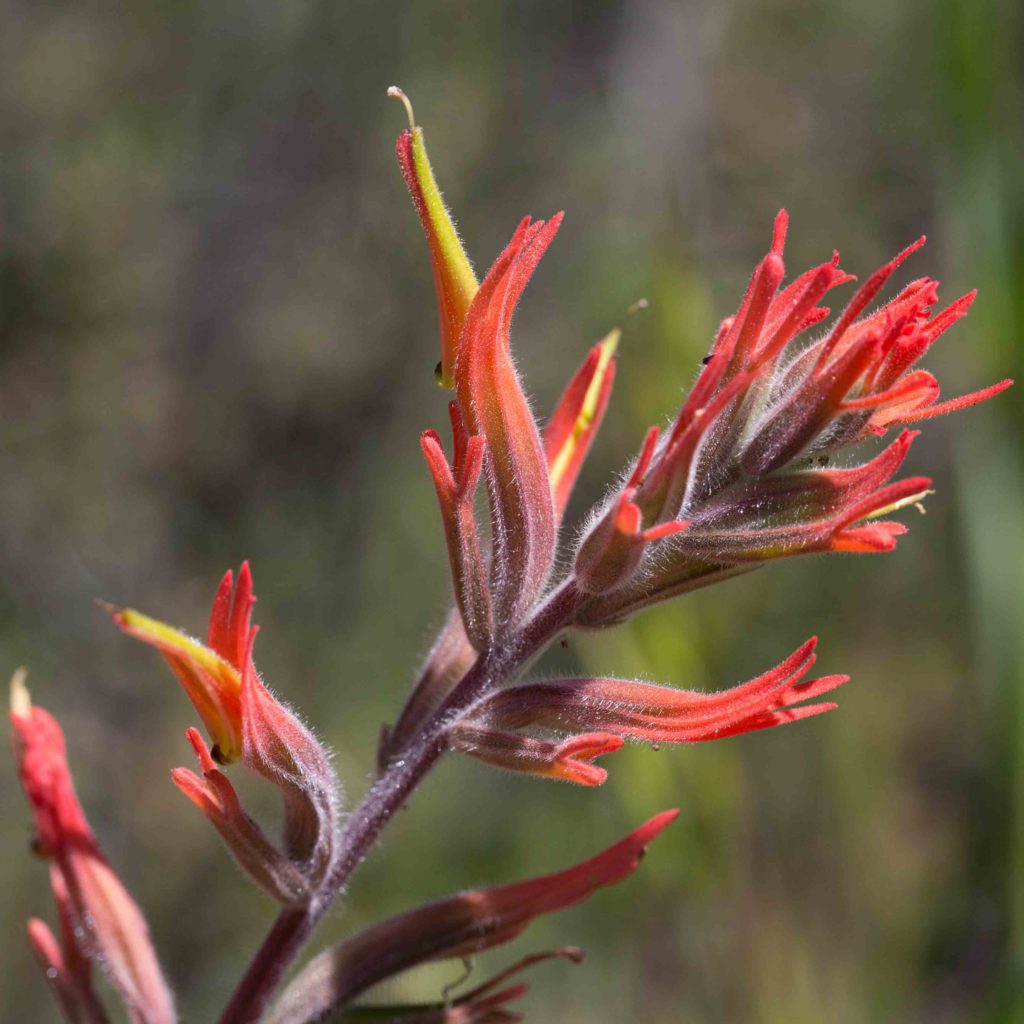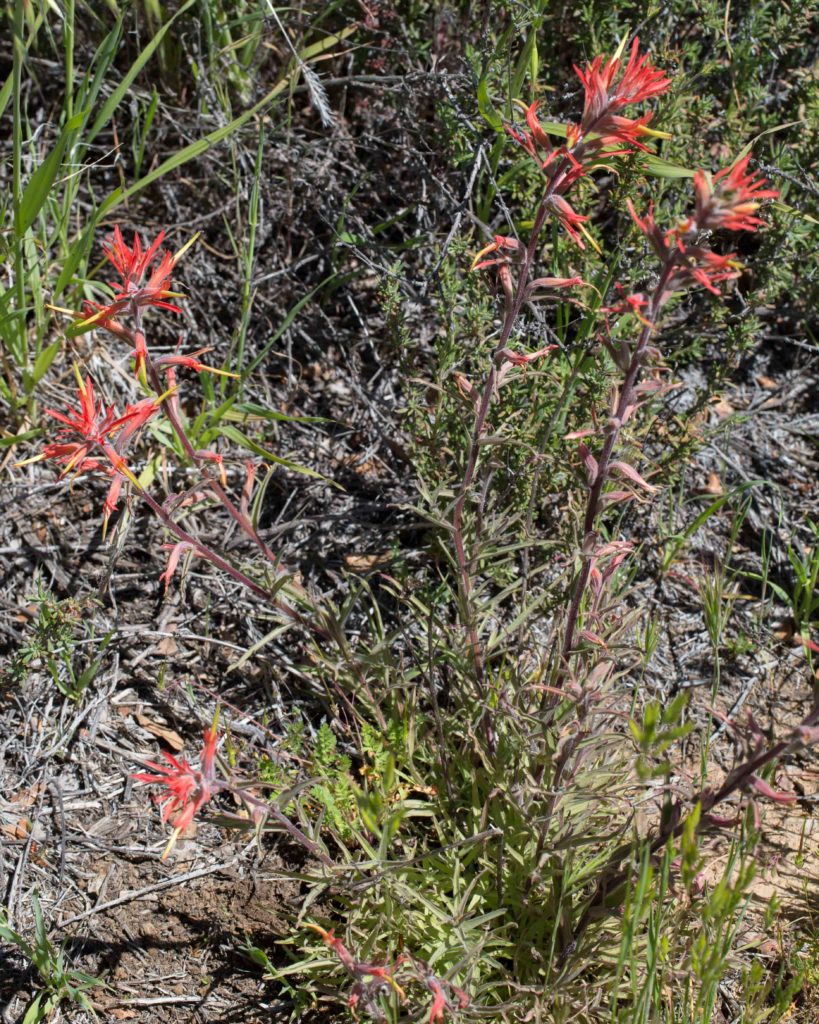Orobanchaceae: Broomrape Family — Castilleja (Paintbrush & Owl’s-clover)
Members of the broomrape family are all root parasites. The Aphyllon (formerly Orobanche) genus is fully parasitic. Its members have no green leaves capable of photosynthesis, therefore they can’t use sunlight for energy. Others, like Castilleja and Pedicularis, are hemiparasitic, meaning they have photosynthetic green leaves, but also derive some of their nutrients from nearby plants.
Castilleja fall into two groups, those with bright red, orange or yellow flowers but without a 3-pouched lower lip (the Paintbrushes), and those with a 3-pouched lower lip but flowers which are a variety of colors, but not bright red (the Owl’s-clovers).
Coast Indian Paintbrush – Castilleja affinis subsp. affinis
Blooms:
Mar–June
Plant Height:
15–60 cm
Flower Size:
Medium cluster
Origin:
Native
Habitat:
Wooded or brushy slopes
Notes:
A common paintbrush, especially near the coast, with flowers that are generally bright red or reddish-orange. What appear to be petals are in fact bracts. The flowers are thin green tubes (red on the underside) that extend out of the red-tipped green calyxes. Photo #2 by CJH.
Pink Johnny Nip – Castilleja ambigua subsp. insalutata
Blooms:
May–Aug
Plant Height:
10–30 cm
Flower Size:
Small cluster
Origin:
Native
Rare or endangered?
Yes – 1b.1
Habitat:
Grassy coastal bluffs
Notes:
This is a form of Owl’s-clover, i.e. those Castilleja with 3-pouched lower corolla lip and flowers that are never bright red. It differs from other owl’s-clovers in its many-branched growth habit, and in the color of its bract tips. There are two subspecies (ambigua and insalutata), which are differentiated by 1) the color of their corollas and bract-tips, and 2) by the length of the tooth that is exserted from the top of the lower lip pouches. The Jepson Manual comments that this species is highly variable and difficult. The plants illustrated below are believed to be subsp. insalutata (despite being identified as subsp. ambigua in Yeager & Mitchell).
Martin’s Paintbrush – Castilleja applegatei subsp. martinii
Blooms:
May–Sept
Plant Height:
30–80 cm
Flower Size:
Medium cluster
Origin:
Native
Habitat:
Dry slopes in interior, generally above 300 m
Notes:
This is similar to Coast Indian Paintbrush (Castilleja affinis, see above), but the inflorescence is consistently bright red, and the plant is more branched from a woody base. Stems are glandular below the inflorescence. Leaves are usually unlobed (but may have up to 3 lobes), and are noticeably crisped, whereas those of Coast Indian paintbrush are merely wavy.
Narrow-leaved Owl’s-clover / Valley Tassels – Castilleja attenuata
Blooms:
Mar–May
Plant Height:
10–50 cm
Flower Size:
Large cluster
Origin:
Native
Habitat:
Grassland
Notes:
This is the only Owl’s-clover with bract tips that are white, rather than pink or purple. The entire plant is slender, including the inflorescence, giving it a wispy appearance. The corolla pouches are slender and only slightly inflated. Leaves are long (2–8 cm), more or less linear with 0–3 lobes. The tip of the beak (upper flower lip) is straight and not noticeably hairy, features it shares with Denseflower Owl’s-clover. Bract tips are usually white, but may be pale yellow or pink, typically with yellow or purple dots.
CAUTION: white forms of Denseflower Owl’s-clover (Castilleja densiflora subsp. densiflora, see below) are sometimes seen, but can be distinguished easily by their broader inflorescences, and more inflated pouches. The photo on the right is Denseflower Owl’s-clover (included to show the difference in pouches). Thanks to Mark Egger for his help on this species. Photos #1 and 3 by CJH.
Denseflower Owl’s-clover– Castilleja densiflora subsp. densiflora
Blooms:
Mar–May
Plant Height:
10–40 cm
Flower Size:
Medium cluster
Origin:
Native
Habitat:
Grassland
Notes:
This is similar to and could be mistaken for Purple Owl’s-clover (Castilleja exserta, see below). However, it is slimmer with longer, linear (but not thread-like) leaves (2–8 cm) with 0–3 lobes. The most apparent difference (on close examination) is the appearance of the beak (upper flower lip); it is straight, and not noticeably hairy. The bracts are more or less as long as the flowers. This is sometimes found with white flowers, as shown in the last photo. In this case, it could be confused with Narrow-Leaved Owl’s-clover (C. attenuata, see above), which always has white flowers. But this can be identified by its corolla pouches, which are broader and much more inflated than those in Narrow-Leaved.
Graceful Owl’s-clover– Castilleja densiflora subsp. gracilis
Blooms:
Mar–May
Plant Height:
10–40 cm
Flower Size:
Medium cluster
Origin:
Native
Habitat:
Grassland, south county
Notes:
Although the same species as Denseflower Owl’s-clover (subsp. densiflora, see above), this is quite different in its appearance. The corollas are exserted, with an abruptly inflated lower lip and a shorter calyx. The lip is generally white, but deep pink forms are not uncommon. The bracts are shorter than the flowers. Common on Fort Hunter Liggett and the Indians.
Purple / Pink Owl’s-clover– Castilleja exserta subsp. exserta
Blooms:
Mar–May
Plant Height:
10–45 cm
Flower Size:
Medium cluster
Origin:
Native
Habitat:
Grassland
Notes:
The most common form of owl’s-clover, this is typically broader than Denseflower Owl’s-clover (Castilleja densiflora subsp. densiflora, see above). Other differences: it has flowers that can be white, but are usually purple-red. This has a very different beak (upper flower lip), noticeably hairy and hooked. Also, these leaves are a little shorter (1–5 cm), thread-like and with 5–9 lobes. Photo #4 by CJH.
Woolly Indian Paintbrush – Castilleja foliolosa
Blooms:
Mar–June
Plant Height:
30–60 cm
Flower Size:
Medium cluster
Origin:
Native
Habitat:
Dry open rocky places, many communities
Notes:
This is similar to Coast Indian Paintbrush (Castilleja affinis, see above), but distinguished by the woolly hairs on its stem, leaves and bracts which give the plant a whitish-gray appearance. Although the inflorescences may be bright red, they are also commonly reddish-orange or even yellow, sometimes on the same plant.
Seaside Painted Cup / Monterey Coast Paintbrush – Castilleja latifolia
Blooms:
Mar–Sept
Plant Height:
30–60 cm
Flower Size:
Medium cluster
Origin:
Native
Rare or endangered?
Yes – 4.3
Habitat:
Sandy places by coast, rarely inland
Notes:
This is the most common paintbrush by the immediate coast, distinguished by its bracts which are broad, wedge-shaped to obovate, and generally unlobed. Inflorescences vary in color, including bright red, orange-red and yellow. The plant is hairy, gray-green with short broad leaves, becoming purple with age. Photos #1 and 3 by CJH.
Longleaf Paintbrush – Castilleja subinclusa subsp. subinclusa
Blooms:
Apr–July
Plant Height:
30–120 cm
Flower Size:
Small cluster
Origin:
Native
Habitat:
Open chaparral (Diablo Range)
Notes:
This paintbrush is distinguished by its calyx, which is more deeply cleft on its lower side, revealing more of the lower corolla lip, and with upward-curving upper lobes. The inflorescence is less dense than those of some other paintbrushes. The plant is slightly hairy but not woolly. Leaves may have 0–3 lobes. Bracts are generally entire, with bright red or orange tips. It is found in Monterey County only in the Inner Coast Ranges.













